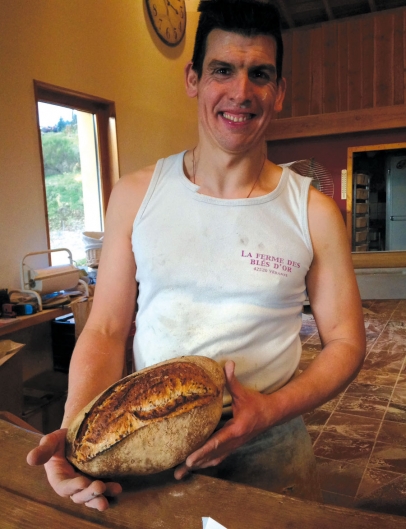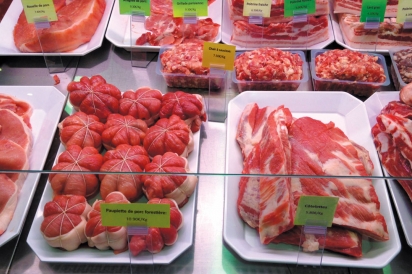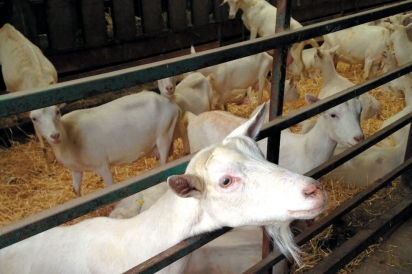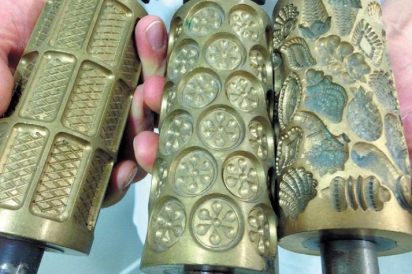The Edible Traveler: A New Wave of French Artisans
A confiserie that includes a museum and candy-making demonstrations? A bread maker on a narrow stretch of road who grows his own wheat, mills it into flour and bakes it into gorgeous loaves in a wood oven? A cheesemaker who keeps his herd of 250 goats just a long stone’s throw up a dirt road from his small cheesemaking rooms? A charcutière couple who raise the pigs they transform into the sausages, pâtés and roasts on display behind a gleaming glass showcase inside the old stone building that houses their shop and equipment?
I was enchanted to discover each of these places in the Parc du Pilat on a brief wander with a friend through the Northern Rhone wine region in France.
Perhaps most surprisingly, these establishments are not the last-standing remnants of a bygone era, manned by the aged remaining few of past generations, but new, vibrant artisanal establishments created by young people set in what I can only describe as la France profonde, where bucolic countryside lives in harmony with the simple life of small farms and villages, far from the modern trappings of Paris and the larger cities.
The Parc du Pilat, where these young artisans are honing their crafts, is in a mountainous region just barely off the beaten path between Lyon and St. Etienne, yet a world away. The 66,000-hectare (163,000-acre) area was created in 1974 as a regional natural parc, or park, through an agreement between a collection of rural hamlets, villages and other entities, and the national government. The collective mission of these designated areas is to assist in protecting the countryside and traditional ways of life through official recognition of places of exceptional natural beauty and heritage and to assist the region in promoting sustainable development, which includes young, entrepreneurial artisans, such as the candy maker, cheesemaker, charcutières and baker that I visited.
“Les Bonbons de Julien” was created by Julien and Jennifer Taboury. They started their candy making in 2007 in a nearby village before moving to their new location in an industrial section of Bourg-Argental, less than 30 minutes from Lyon. The Tabourys are both trained in food production, and Julien had worked for the famous chocolate house Valhrona before deciding to follow his passion: old-fashioned candy. Their modest museum on site is homage to the past, with vintage candy molds, labels, tins and equipment on display. The retail shop is filled from floor to ceiling with brilliantly colored suckers in different shapes, boxes of the classic three-sided berlingot hard candies, delicate pastel marshmallows and richly hued squares of pâte de fruit.
Only natural and organic ingredients go into the couple’s candies, and that includes the colorants. For example, the bright red color of the strawberry suckers and hard candies comes from beets and the shimmering green of the lime candies comes from spinach.
On Sundays, Julien, who looks even younger than his 30-something years, puts on a white apron and invites anyone wanting to attend into his workshop, where he stands behind a long marble slab and demonstrates the whirling, twisting and turning that transforms sugar, flavors and colorants into sparkling candy. I was enthralled to see him twist a huge mass of pale pink paste into striped, clear candies. During July and August he gives the demonstration daily, and last year more than 60,000 visitors came to watch him work his magic.
Only a few kilometers away, in the village of La Chaize Pélussin, my friend and I spotted a very small storefront, nearly windowless, with a sign announcing “La Cabriole” and “please ring the bell.” André Boucher, cheesemaker and owner of La Cabriole with his wife, Marie-Laure, answered the bell and invited us in. Inside, he showed us the back rooms where small goat cheeses were in various stages of production. Several helpers were ladling curd into molds, and others were turning cheeses out of molds onto racks to cure.
M. Boucher explained to us that his parents were “people of ’68,” referring to the young people, many of them intellectuals, who left the cities, especially Paris, in 1968, after the student rebellions, seeking a sustainable rural life. His parents had installed themselves on a small farm here in La Chaize Pélussin, with a few cows and apple trees. Soon they got goats and began making cheese.
This French “back to the earth” movement, nearly 50 years ago, was something that I had participated in, even though I am not French, and I listened to M. Boucher’s story with a certain nostalgia. Like his parents, I, too, bought a small farm and learned to make goat milk cheese, using very much the same method he uses today. Mine was much more rustic, however, and I wrote about it in my memoir, A Pig in Provence.
M. Boucher worked hard, along with about 30 other local cheesemakers, to have the region’s distinctive cheese, Rigotte de Condrieu, recognized. Taking its name from the famous wine of the region, Condrieu, it is a small goat milk cheese made with raw milk and aged to develop its distinct texture and nutty, buttery flavor. In 2009, it became one of 45 French cheeses to receive the AOC, or appellation d’origine contrôlée, and today also holds the AOP, or appellation d’origine protégée, granted by the European Union.
His goats are fed only non-GMO feed and about 80% of it is locally grown. Clearly delighting in the rural life for himself and his young family, he showed us the herd of goats his brother takes care of, the view from his storefront of Mont Blanc in the distance, and, with a wave of his arm, indicated “the great valley of consumers in the Rhone Valley,” anchored by Lyon, France’s third largest city, less than an hour away.
Just down the road from La Cabriole, we visited the charcuterie of Gaëc des Hirondelles, owned and operated by Jean-Marc and Sonia Manoa. They raise specific breeds of hogs that are then farmed out at 40 to 50 pounds to farmers to be raised according to the couple’s specifications. At around 250 pounds, the hogs are processed, 14 per week, at an abattoir. Back at the butcher shop the meat is transformed into pâtés, terrines, roasts, chops and more. The Manoas even make their own dough for the pâté en croûte, using the lard rendered from their pigs. Everything is done from scratch. Part of the feed for the animals is the protein-rich petit lait, or whey, from M. Boucher’s cheesemaking operation, and another part is bran from the milling operation at La Ferme des Bles d’Or, not far down the road.
Noël Lafertine, who owns La Ferme des Bles d’Or, is a 37-year-old bundle of energy. While he talked to us in his bakery, he kneaded and shaped at least 50 loaves of pain au levain, readying them for his huge, wood-fired oven, then took us through a set of heavy doors to the back room. There, pallets of grain were stacked on high shelving, and to one side stood a mill. He explained that he grows and mills the wheat himself, then bakes the bread himself. His only assistant comes on the three afternoons a week he is open for retail, to help out at the register.
“I want to bake bread like my grandmother made in the wood oven of their farmhouse,” he told me.
I don’t know what her bread tasted like, but the loaves he gave us, fresh from the wood oven, were hard-crusted, intensely flavored ovals that were excellent with the Rigotte de Condrieu cheese, the Saucisse Maison of Gaëc des Hirondelles, and a half bottle of vintner Yves Cuilleron’s lush Condrieu wine.
For more information, visit EdibleMarinAndWineCountry.com








